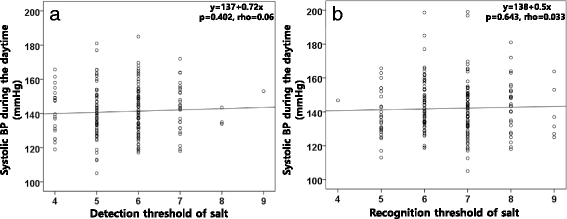The salt-taste threshold in untreated hypertensive patients
- PMID: 29163986
- PMCID: PMC5686816
- DOI: 10.1186/s40885-017-0079-8
The salt-taste threshold in untreated hypertensive patients
Abstract
Background: The salt-taste threshold can influence the salt appetite, and is thought to be another marker of sodium intake. Many studies have mentioned the relationship between the sodium intake and blood pressure (BP). The aim of this study was to evaluate the relationship between the salt-taste threshold and urinary sodium excretion in normotensive and hypertensive groups.
Methods: We analyzed 199 patients (mean age 52 years, male 47.3%) who underwent 24-h ambulatory BP monitoring (ABPM). Hypertension was diagnosed as an average daytime systolic BP of ≥135 mmHg or diastolic BP of ≥85 mmHg by the ABPM. We assessed the salt-taste threshold using graded saline solutions. The salt-taste threshold, 24-h urinary sodium and potassium excretion, and echocardiographic data were compared between the control and hypertensive groups.
Results: The detection and recognition threshold of the salt taste did not significantly differ between the control and hypertensive groups. The 24-h urinary sodium excretion of hypertensive patients was significantly higher than that of the control group (140.9 ± 59.8 vs. 117.9 ± 57.2 mEq/day, respectively, p = 0.011). Also, the urinary sodium-potassium ratio was significantly higher in the hypertensive patients. There was no correlation between the salt-taste threshold and 24-h urinary sodium excretion.
Conclusions: The salt-taste threshold might not be related to the BP status as well as the 24-h urinary sodium excretion.
Keywords: Hypertension; Sodium; Taste.
Conflict of interest statement
Ethics approval and consent to participate
This study was approved by the institutional review board of Daegu Catholic Medical Center.
Consent for publication
Not applicable.
Competing interests
The authors declare that they have no competing interests.
Publisher’s Note
Springer Nature remains neutral with regard to jurisdictional claims in published maps and institutional affiliations.
Figures




Similar articles
-
Relationship between salt intake, salt-taste threshold and blood pressure in Nigerians.West Afr J Med. 2011 Sep-Oct;30(5):373-6. West Afr J Med. 2011. PMID: 22752827
-
Genetic predisposition to salt-sensitive normotension and its effects on salt taste perception and intake.Br J Nutr. 2018 Oct;120(7):721-731. doi: 10.1017/S0007114518002027. Epub 2018 Aug 14. Br J Nutr. 2018. PMID: 30105963
-
[Salt taste threshold, 24 hour natriuresis and blood pressure variation in normotensive individuals].Rev Assoc Med Bras (1992). 2007 Mar-Apr;53(2):142-6. doi: 10.1590/s0104-42302007000200019. Rev Assoc Med Bras (1992). 2007. PMID: 17568918 Portuguese.
-
A Meta-Analysis of Effect of Dietary Salt Restriction on Blood Pressure in Chinese Adults.Glob Heart. 2015 Dec;10(4):291-299.e6. doi: 10.1016/j.gheart.2014.10.009. Epub 2015 Feb 7. Glob Heart. 2015. PMID: 26014655 Free PMC article. Review.
-
Clinical value of ambulatory blood pressure monitoring.J Hypertens. 1999 May;17(5):585-95. doi: 10.1097/00004872-199917050-00001. J Hypertens. 1999. PMID: 10403601 Review.
Cited by
-
Paucity of high-quality studies reporting on salt and health outcomes from the science of salt: A regularly updated systematic review of salt and health outcomes (April 2017 to March 2018).J Clin Hypertens (Greenwich). 2019 Feb;21(2):307-323. doi: 10.1111/jch.13450. Epub 2018 Dec 27. J Clin Hypertens (Greenwich). 2019. PMID: 30589204 Free PMC article.
-
Elevated Salt Taste Threshold Is Associated with Increased Risk of Coronary Heart Disease.J Cardiovasc Transl Res. 2020 Dec;13(6):1016-1023. doi: 10.1007/s12265-020-10017-4. Epub 2020 May 6. J Cardiovasc Transl Res. 2020. PMID: 32378162
-
Genetic Variation in Taste Receptor Genes (SCNN1B, TRPV1) and Its Correlation with the Perception of Saltiness in Normotensive and Hypertensive Adults.Int J Hypertens. 2021 Jun 4;2021:5559831. doi: 10.1155/2021/5559831. eCollection 2021. Int J Hypertens. 2021. PMID: 34150338 Free PMC article.
-
The Association between Salt Taste Perception, Mediterranean Diet and Metabolic Syndrome: A Cross-Sectional Study.Nutrients. 2020 Apr 22;12(4):1164. doi: 10.3390/nu12041164. Nutrients. 2020. PMID: 32331287 Free PMC article.
-
Association between salt taste sensitivity threshold and blood pressure in healthy individuals: a cross-sectional study.Sao Paulo Med J. 2020 Jan-Feb;138(1):4-10. doi: 10.1590/1516-3180.2019.0166.R1.02102019. Sao Paulo Med J. 2020. PMID: 32130310 Free PMC article.
References
-
- MacMahon S, Peto R, Cutler J, Collins R, Sorlie P, Neaton J, et al. Blood pressure, stroke, and coronary heart disease. Part 1, prolonged differences in blood pressure: prospective observational studies corrected for the regression dilution bias. Lancet (London, England) 1990;335(8692):765–774. doi: 10.1016/0140-6736(90)90878-9. - DOI - PubMed
-
- Han W, Han X, Sun N, Chen Y, Jiang S, Li M. Relationships between urinary electrolytes excretion and central hemodynamics, and arterial stiffness in hypertensive patients. Hypertension research : official journal of the Japanese Society of Hypertension. 2017; - PubMed
LinkOut - more resources
Full Text Sources
Other Literature Sources
